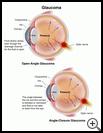
Glaucoma: Open-Angle
________________________________________________________________________
KEY POINTS
- Glaucoma is an eye disease that damages the nerve that carries messages from the eye to the brain. This is usually caused by high pressure inside the eye. The fluid in the front of the eye is constantly flowing from where it is formed into drainage channels, and is then reabsorbed by the body. When fluid flows out too slowly, the pressure in the eye increases.
- Treatment may include eye drops, pills, laser procedures, or surgery. Some of these treatments reduce the amount of fluid your eyes make. Other treatments make fluid drain from the eye better. Treatment helps prevent further vision loss. It does not make your vision better.
________________________________________________________________________
What is open-angle glaucoma?
Glaucoma is an eye disease that damages the nerve that carries visual messages to the brain (optic nerve). This is usually caused by high pressure inside the eye. Damage to the optic nerve can cause a permanent loss of vision. Glaucoma needs to be diagnosed and treated early to prevent blindness. Vision loss due to glaucoma often cannot be reversed
Normally, the fluid in the front of the eye is constantly flowing from where it is formed (the ciliary body) to the front of the eye. This fluid nourishes your eye and helps to keep its shape. The area between the iris (colored part of the eye) and the cornea (the clear outer layer on the front of the eye) is called the angle. Fluid drains out through the angle, into drainage channels, and is then reabsorbed by the body. When fluid flows out too slowly, eye pressure builds up.
In open-angle glaucoma, fluid drains slowly, causing the pressure in the eye to increase. This happens even though the drainage channel for the fluid appears to be open. Open-angle glaucoma gets worse gradually if not treated.
Open-angle glaucoma is one of the 2 main types of glaucoma. It is the more common type of glaucoma in the US.
What is the cause?
One type of open-angle glaucoma is caused by injury to the eye. It may show up months or years after the injury. This type of glaucoma may not respond to some common glaucoma medicines, and surgery may be needed.
Occasionally, nerve damage happens without high pressure in the eye. In most cases of open angle glaucoma, it is not known what causes the fluid to drain out too slowly. Using your eyes for close work or in poor light does not increase your chances of having glaucoma.
Open-angle glaucoma:
- Occurs most often after age 55 but sometimes happens in children
- Tends to run in families
- Is more common among black people than white people
What are the symptoms?
Open-angle glaucoma often causes no symptoms in the early stages. In later stages, you will begin to notice a loss of vision. Side vision is usually affected first. Glaucoma only causes eye pain if the pressure is very high.
How is it diagnosed?
Your eye care provider may:
- Measure the pressure in your eyes and the thickness of your cornea
- Check for changes in your side vision caused by damage to the optic nerve
- Look at the optic nerve inside your eye
- Examine the drainage channels with a special mirrored lens
How is it treated?
The goal of treatment is to reduce the pressure in your eyes and decrease damage to the optic nerve. Treatment helps prevent further vision loss. It does not make your vision better. This may be done with eye drops, pills, laser procedures, or surgery. Some of these treatments reduce the amount of fluid your eyes make. Other treatments make fluid drain from the eye better.
For open-angle glaucoma, eye drops may be the only treatment you need. Your eye care provider may want to check your eyes often to see if the medicine is working. The medicine may cause side effects. Ask your healthcare provider or pharmacist what side effects the medicine may cause and what you should do if you have side effects.
If your healthcare provider prescribes medicine to control the pressure, you may need to take it for the rest of your life.
Laser treatments can lower pressure in the eyes. However, the procedure may need to be repeated.
A filtering surgery (trabeculectomy or tube shunt) may be recommended if other treatments do not work. In this procedure, the provider creates a new pathway to drain fluid from the eye.
Treatment helps prevent further vision loss. It does not make your vision better.
How can I take care of myself?
- Have regular, complete eye exams, according to your provider's recommendation.
- Learn about your family history. Open-angle glaucoma often runs in families. Let your family members know if you have been diagnosed with glaucoma so that they can be checked.
- Use your medicine as directed. If it is hard for you to use the medicine correctly, let your provider know. Other treatments may work better for you.
- See your eye care provider right away if you notice any changes in your vision.
How can I help prevent open-angle glaucoma?
Open-angle glaucoma cannot be prevented. However, blindness can be prevented if glaucoma is treated before pressure in the eye has damaged the optic nerve too much.
You may be able to help prevent glaucoma from becoming severe if you have regular eye exams that include measuring the pressure in your eye and examining your optic nerve. How often you need to see the eye care provider will depend on how severely your optic nerve is damaged.

